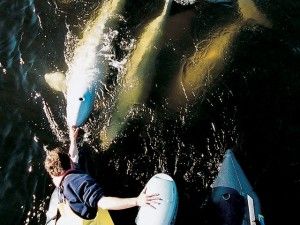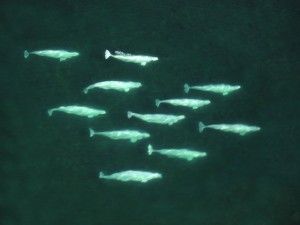Most of the time, polar bears overshadow other arctic wildlife on our Churchill Wild adventures. Beluga whales are another species prevalent around Churchill in the summer however, and since they’re a popular part of our Birds, Bears & Belugas adventure, we thought it might be nice to share with you a few things that we find interesting about these friendly-faced mammals.
- While you likely know that beluga whales are white, it’s unlikely you’re aware that the name ‘beluga’ comes from the Russian word “Belukha” which means white.
- Beluga whales are also known as “sea canaries” due to the unique and varied sounds they make. On our Birds, Bears & Belugas adventure at Seal River Heritage Lodge, we offer guests a chance to snorkel with the belugas, and those who have done so can testify to the fact that humming and chirping attract these friendly creatures!
-
Baby belugas are born gray and turn white as they age. Due to their darker color, they are thought to be more difficult to spot by predators such as polar bears and killer whales. Most belugas are completely white around the age of 13 when sexual maturity is reached.
- Belugas are very sociable and as such, their sense of touch is very important. It is not unusual for belugas to come close enough to the boats and snorkelers to be touched.
- Beluga whales undergo a seasonal molt, unlike other cetaceans which shed continuously. They rub against rocky river bottoms to shed their skin, which could be why they’re often found in shallow water in the summertime.
- Belugas, like other toothed whales, have a life expectancy of 30-40 years, nearly half that of the average life expectancy of most baleen whales.
-
In the summer, belugas are often found in warm-water estuaries and river basins, making our Lodge, located near the Seal River estuary, an ideal place to view them.
- The seven vertebrae in a beluga’s neck are not fused, which gives them the ability to turn their heads and even nod!
- The lack of a dorsal fin enables beluga whales to swim just below ice sheets to locate breathing holes. Their lack of a dorsal fin also means less surface area, minimizing heat loss when in Arctic waters.
- Spot the difference: Male belugas can be distinguished from females by the upward curve at the top of their flippers as well as by their size. Adult males can weigh up to 1500 kg, while mature females weigh in at about 1350 kg.
Oh, and one more thing we’ve learned from guests on our Birds, Bears and Belugas adventures – swimming with Belugas is a fun!
Related Posts:
Churchill Wild Birds, Bears and Belugas trip featured in L.A. Times Travel Section
Swim with beluga whales. Conquer your fears.












Join the discussion One Comment